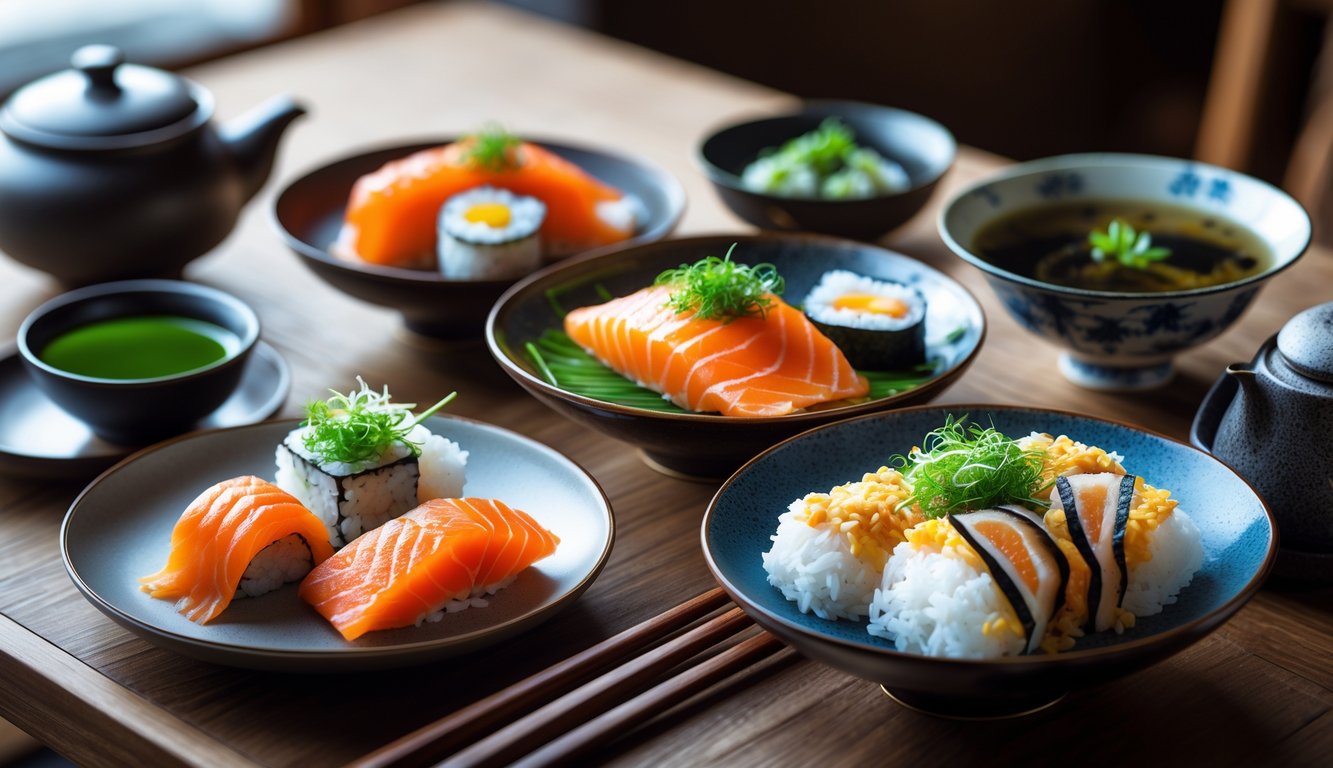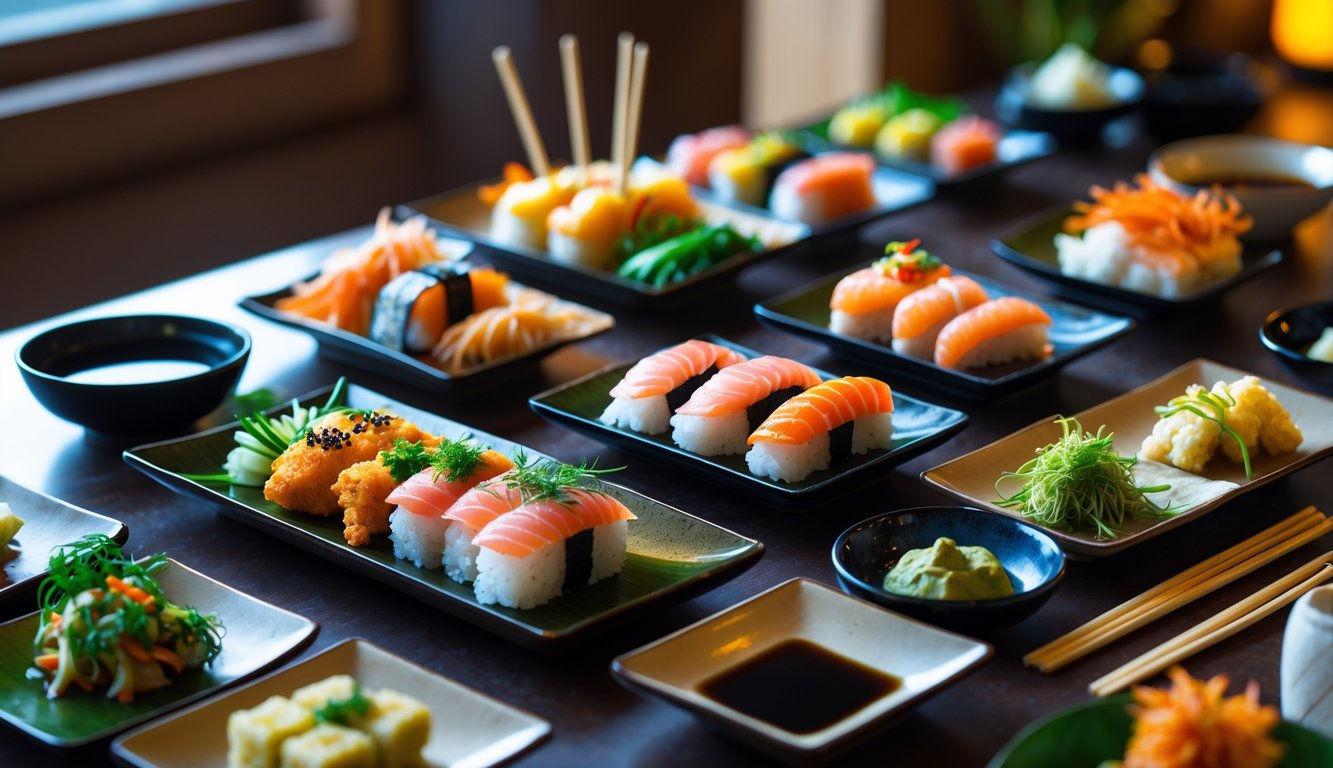
Dynamic Dining: Small Plates And Sharing

People talk about portion control like it’s punishment, but Japanese meals? Total chaos. No giant entrees—just a million little plates, always moving, always someone stealing the last bite. You never just sit there; you’re reaching, passing, side-eyeing your friend for hogging the tempura.
Izakaya Culture
You can’t plan an izakaya night. It’s a mess, in a good way. Starts with edamame, next thing you know, yakitori skewers everywhere, someone orders too much, nobody minds. Sharing small plates isn’t etiquette, it’s survival.
Someone’s always overusing soy sauce, dunking fried chicken, arguing about ponzu. Chefs brag that tables average 7–12 dishes—nobody counts, but it’s believable. Sashimi hits the table, it’s gone. Dishes keep rotating, nothing gets boring—a psychologist in Nikkei Asian Review says this “novelty” is why it’s satisfying. Maybe. My friend Jun just says more flavors means more fun, and he’s not wrong.
bento Boxes
Bento. Actual boxes, not just cute lunch things. You get rice, maybe with sesame, a rectangle of tamagoyaki, two pickled radishes, and a piece of fish staring at you. No blending, no mixing—each bite is its own deal. Convenience stores crank out tens of thousands daily—Nikkei said 50,000+ per store, which sounds fake, but maybe not.
Kaiseki chefs obsess over order, but families just pile in whatever. After years of business trips, I learned one thing: soggy seaweed is inevitable. Packaging is an art form. Nutritionists claim the little compartments help with portion control and variety. I’m not sure about “mindful eating,” but I do know cold karaage never gets soggy in those plastic corners.
Street Food Favorites
Street food? No apologies. One minute you’re fighting crowds in Dotonbori, next you’re burning your mouth on takoyaki, pretending you waited. Vendors brag about “octopus ratio” per ball—who’s counting? Not me.
You can’t eat alone—someone always grabs a bite, trades for yakisoba, nobody keeps track. I’ve seen posters claiming “205% higher satisfaction” with fresh batter (as if that’s a real number). Even the trash tells the story: grab, eat, toss, repeat. That constant sharing and swapping is what makes dinner fun—Japanese-style sharing works because nobody lets things get stale.
Preparation Techniques That Elevate Flavor

Lunch meetings drag on, and somehow I’m hunched over microwaved leftovers, scraping off limp tempura and muttering, “Nope, not even close to Tokyo.” Why does everything taste better there? I blame the details—rice vinegar, that one brand of oil, the way they keep the teppan plates freezing until the last second. It’s infuriating. My kitchen is a graveyard of failed attempts.
Crispy And Light Battering
Picture this: I’m at a street stall, inhaling tempura shrimp, instantly regretting every Western breadcrumb I’ve ever bought. I mean, why did we let panko take over? Chef Akira Watanabe (yeah, the “Essential Japanese Cooking” guy, I looked it up) swears by ice-cold batter, low-gluten flour, and frying so fast it almost feels illegal. If the tempura flops, it’s probably because the oil dropped below 340°F or the batter got bullied into glue. (He says 340°F, but my thermometer’s a liar and always reads 345.)
Honestly, it’s three steps. Use flour so soft it barely sticks to your hands, then dump in a half-heartedly beaten egg and cold water with ice cubes floating around. Cut your yam or prawn into triangles—why triangles? No clue, but everyone does it—then dunk, toss, and yank it out before you can second-guess yourself. I watched some Osaka chef wipe his hands on a towel that looked like it survived a kitchen fire, and suddenly my “clean as you go” mantra felt pointless. The right oil—rice bran or sesame, not olive, never olive—gives you that clean, shatter-crisp finish. It’s not fried chicken, it’s…something else. The translucent crust? Not magic, just technique and temperature. Or maybe a little magic.
Simmered And Braised Dishes
Nikujaga at home: why does it always taste like sad stew instead of that Sapporo izakaya memory I keep chasing? My neighbor (she did time at Tsukiji culinary school, and will fight you over miso) says patience is everything. Apparently, you start with fatty beef—thin slices, nothing lean—so it throws down umami right from the start.
I’ve given up on measuring. Skip the store soy sauce, go for dashi, and toss in whole carrots so you have to fish them out later. After an hour of lazy bubbling, the kitchen smells like someone actually tried. Cookbooks want 200 ml dashi, 2 tbsp soy, 1.5 tbsp sugar. I eyeball it, then taste, then forget what I was doing.
Braising? Don’t boil stuff into oblivion. Keep the heat so low you see a bubble every five seconds, tops. For some reason (science? ghosts?), letting the stew cool and reheating it makes it taste way better. I don’t get it, but steaming and simmering just win. Every time.
Teppanyaki: Tabletop Cooking
At the teppanyaki grill, I’m crammed next to strangers, and nothing sticks. Why? My pans at home turn okonomiyaki into charcoal. The chef—sleeves up, sweating—tells me it’s all about the steel, 425°F, oil so thin it’s almost invisible, spatula never stops moving. The show is half the point, but the other half is real. They salt steak after searing, which I never remember to do.
It’s always chaos. Kids flinging shrimp tails, phones buzzing, onion volcanoes smoking up the place, and the garlic chips vanish before I can grab one. Some study (Japan Food Research Institute, 2018) claims the high heat “seals in juices,” but honestly, I think it’s just speed and bravado. Nobody nails it at home on the first try.
Every bite—ribeye, cabbage, whatever—gets a little char and a glaze I can’t fake in my skillet. The table is the kitchen, and eating slows down because you’re watching, not just chewing. Teppanyaki isn’t just a cooking method; it’s a weird mix of gear, nerve, and not caring if you burn something.



